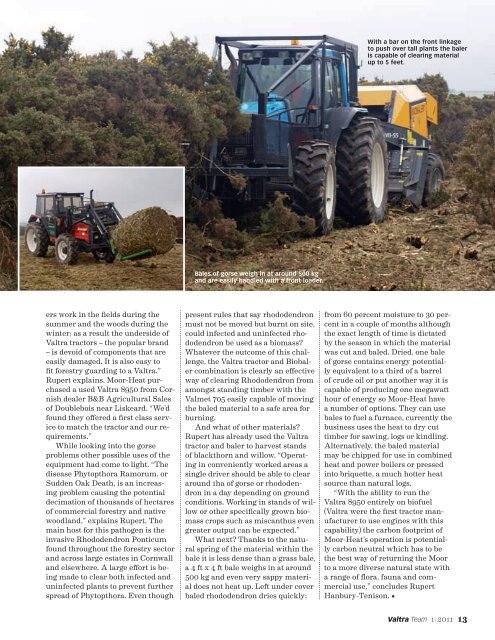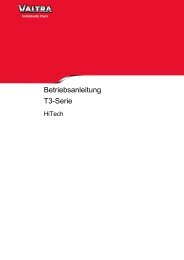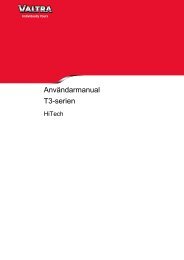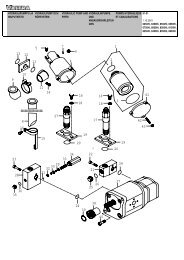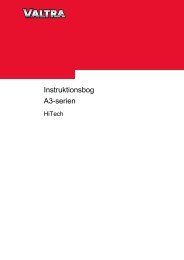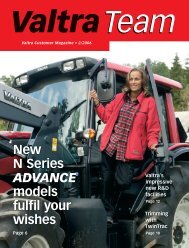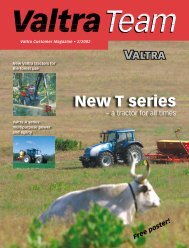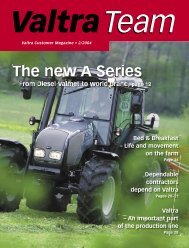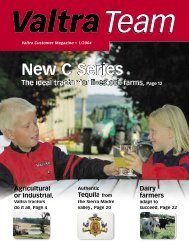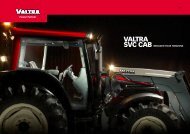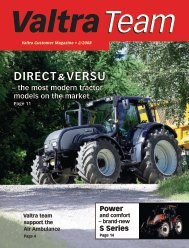Create successful ePaper yourself
Turn your PDF publications into a flip-book with our unique Google optimized e-Paper software.
ers work in the fields during the<br />
summer and the woods during the<br />
winter; as a result the underside of<br />
<strong>Valtra</strong> tractors – the popular brand<br />
– is devoid of components that are<br />
easily damaged. It is also easy to<br />
fit forestry guarding to a <strong>Valtra</strong>.”<br />
Rupert explains. Moor-Heat purchased<br />
a used <strong>Valtra</strong> 8950 from Cornish<br />
dealer B&B Agricultural Sales<br />
of Doublebois near Liskeard. “We’d<br />
found they offered a first class service<br />
to match the tractor and our requirements.”<br />
While looking into the gorse<br />
problems other possible uses of the<br />
equipment had come to light. “The<br />
disease Phytopthora Ramorum, or<br />
Sudden Oak Death, is an increasing<br />
problem causing the potential<br />
decimation of thousands of hectares<br />
of commercial forestry and native<br />
woodland,” explains Rupert. The<br />
main host for this pathogen is the<br />
invasive Rhododendron Ponticum<br />
found throughout the forestry sector<br />
and across large estates in Cornwall<br />
and elsewhere. A large effort is being<br />
made to clear both infected and<br />
uninfected plants to prevent further<br />
spread of Phytopthora. Even though<br />
Bales of gorse weigh in at around 500 kg<br />
and are easily handled with a front loader.<br />
present rules that say rhododendron<br />
must not be moved but burnt on site,<br />
could infected and uninfected rhododendron<br />
be used as a biomass?<br />
Whatever the outcome of this challenge,<br />
the <strong>Valtra</strong> tractor and Biobaler<br />
combination is clearly an effective<br />
way of clearing Rhododendron from<br />
amongst standing timber with the<br />
Valmet 705 easily capable of moving<br />
the baled material to a safe area for<br />
burning.<br />
And what of other materials?<br />
Rupert has already used the <strong>Valtra</strong><br />
tractor and baler to harvest stands<br />
of blackthorn and willow. “Operating<br />
in conveniently worked areas a<br />
single driver should be able to clear<br />
around 1ha of gorse or rhododendron<br />
in a day depending on ground<br />
conditions. Working in stands of willow<br />
or other specifically grown biomass<br />
crops such as miscanthus even<br />
greater output can be expected.”<br />
What next? Thanks to the natural<br />
spring of the material within the<br />
bale it is less dense than a grass bale,<br />
a 4 ft x 4 ft bale weighs in at around<br />
500 kg and even very sappy material<br />
does not heat up. Left under cover<br />
baled rhododendron dries quickly;<br />
With a bar on the front linkage<br />
to push over tall plants the baler<br />
is capable of clearing material<br />
up to 5 feet.<br />
from 60 percent moisture to 30 percent<br />
in a couple of months although<br />
the exact length of time is dictated<br />
by the season in which the material<br />
was cut and baled. Dried, one bale<br />
of gorse contains energy potentially<br />
equivalent to a third of a barrel<br />
of crude oil or put another way it is<br />
capable of producing one megawatt<br />
hour of energy so Moor-Heat have<br />
a number of options. They can use<br />
bales to fuel a furnace, currently the<br />
business uses the heat to dry cut<br />
timber for sawing, logs or kindling.<br />
Alternatively, the baled material<br />
may be chipped for use in combined<br />
heat and power boilers or pressed<br />
into briquette, a much hotter heat<br />
source than natural logs.<br />
“With the ability to run the<br />
<strong>Valtra</strong> 8950 entirely on biofuel<br />
(<strong>Valtra</strong> were the first tractor manufacturer<br />
to use engines with this<br />
capability) the carbon footprint of<br />
Moor-Heat’s operation is potentially<br />
carbon neutral which has to be<br />
the best way of returning the Moor<br />
to a more diverse natural state with<br />
a range of flora, fauna and commercial<br />
use,” concludes Rupert<br />
Hanbury-Tenison. •<br />
<strong>Valtra</strong> <strong>Team</strong> <strong>1|2011</strong> 13


